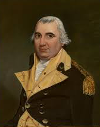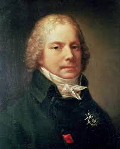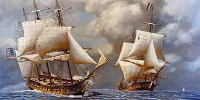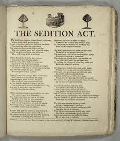The XYZ Affair
The XYZ Affair was a series of diplomatic incidents that resulted in an undeclared naval war between the U.S. and France. 
France had contributed to the U.S. victory over Great Britain in the Revolutionary War. After the French Revolution and a series of subsequent military conflicts between France and other European powers, the U.S. refused to take sides. Moreover, French officials viewed the U.S. signing of the Jay Treaty with Great Britain in 1794 as against French interests, so much so that France refused to recognize the U.S. Minister to France in 1796. That minister was Charles Cotesworth Pinckney (right), appointed by newly elected John Adams. More troublingly, the French Government, known as the Directory, authorized its navy to seize American merchant ships. 
The French official who refused to meet with Pinckney was the foreign minister, Charles Talleyrand (left). When Adams sent a commission of three representatives to try again to meet with Talleyrand, the result was an attempted bribe. The three members of the U.S. commission were Pinckney, Elbridge Gerry, and John Marshall. Talleyrand didn't meet with the American commissioners; instead, he sent three representatives of the French government, Pierre Bellamy, Lucien Hauteval, and Jean-Conrad Hottinguer. The French representatives told the American commissioners that France would see things entirely America's way if the American Government would pay Talleyrand himself $250,000 and the French Government $10 million. The Americans refused to take the bribe and sent a report back to President Adams, to make him aware of what happened. Pinckney and his other commissioners knew the names of the French representatives but, in the report they sent to In the wake of this economic and political uncertainty, Congress passed the Alien and Sedition Acts, targeting French and Irish immigrants (the latter of which were suspected of being willing to support French interests over American interests). Among the provisions of this pair of internal security acts were the On the international front, Talleyrand and the French Government, not relishing having yet another nation to fight, signaled that they would be willing to discuss matters again. A new U.S. delegation (William Richardson Davie, Oliver Ellsworth, and William VansMurray) found more of a welcome in France (represented by this time by Napoleon Bonaparte, who had overthrown the Directory in 1799), and the result was the Treaty of Mortefontaine, which ended the undeclared naval war and returned relations between France and the U.S. to most favored nation status. Among the particulars of the treaty, also known as the Convention of 1800:
Marshall, one of the original commissioners sent to France, oversaw treaty negotiations because he was by then Secretary of State. Also by this time, Pinckney was the U.S. Ambassador to Spain; he tried to convince Spain to part with Florida and the Louisiana Territory, but Spain wasn't having anything of it. France assumed control of the Louisiana Territory and, in 1803, offered to sell the entirety of it to the U.S. Because relations between the two countries were very good by this time, negotiations in relation to that land exchange proceeded without incident. The result was the Louisiana Purchase. |
|
Social Studies for Kids
copyright 2002–2025
David White



 Congress, referred to them as X (Hottinguer), Y (Bellamy), and Z (Hauteval). Congress was outraged at the attempted bribe; the American public was angry, too. The result was a sharp increase in tensions between the two nations, culminating in an undeclared naval war known as the Quasi War, which featured conflict between the two nations in the Caribbean. The U.S. created the Department of the Navy and began to spend money on warship construction.
Congress, referred to them as X (Hottinguer), Y (Bellamy), and Z (Hauteval). Congress was outraged at the attempted bribe; the American public was angry, too. The result was a sharp increase in tensions between the two nations, culminating in an undeclared naval war known as the Quasi War, which featured conflict between the two nations in the Caribbean. The U.S. created the Department of the Navy and began to spend money on warship construction. extension of the naturalization period and the authorization of the detention of residents of a nation judged to an enemy of the U.S. (Alien Act) and a crackdown on the ability of the press to criticize the Government (Sedition Act). These acts angered many in America and resulted in an ebb of support for the majority
extension of the naturalization period and the authorization of the detention of residents of a nation judged to an enemy of the U.S. (Alien Act) and a crackdown on the ability of the press to criticize the Government (Sedition Act). These acts angered many in America and resulted in an ebb of support for the majority 

